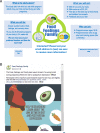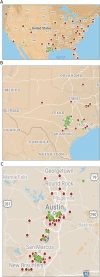The Food, Feelings, and Family Study: comparison of the efficacy of traditional methods, social media, and broadcast email to recruit pregnant women to an observational, longitudinal nutrition study
- PMID: 33711946
- PMCID: PMC7953646
- DOI: 10.1186/s12884-021-03680-1
The Food, Feelings, and Family Study: comparison of the efficacy of traditional methods, social media, and broadcast email to recruit pregnant women to an observational, longitudinal nutrition study
Abstract
Background: It is well known that recruitment is a challenging aspect of any study involving human subjects. This challenge is exacerbated when the population sought is reticent to participate in research as is the case with pregnant women and individuals with depression. This paper compares recruitment methods used for the Food, Feelings, and Family Study, an observational, longitudinal pilot study concerning how diet and bisphenol A exposure affect maternal mood and cognitive function during and after pregnancy.
Methods: Pregnant women were recruited to this study over a period of 15 months using traditional methods, social media including paid and unpaid posts, and emails broadcast to the university community. Contingency analysis using the Pearson's Chi-square test was used to determine if recruitment method was associated with likelihood of participation. T-tests were used to analyze Facebook advertisement success. ANOVAs and Fisher exact tests were used to determine if recruitment method was related to continuous and categorical demographics, respectively.
Results: Social media resulted in the largest number of recruits, followed by traditional methods and broadcast email. Women recruited through social media were less likely to participate. In contrast, use of broadcast email resulted in a smaller pool of recruits but these recruits were more likely to be eligible for and complete the study. Most women recruited via social media were the result of unpaid posts to the study's Facebook page. Paid posts lasting at least 4 days were the most successful. Recruitment method was not associated with participant demographics.
Conclusions: Social media has the potential to recruit a large pool of potential subjects; however, when studies require a large time investment such as the case here, women recruited through social media are less likely to participate and complete the study than women recruited through other means.
Trial registration: N/A. This study does not describe a health care intervention.
Keywords: Depression; Nutrition; Pregnant; Recruitment; Social media.
Conflict of interest statement
The authors declare that they have no competing interests.
Figures




Similar articles
-
Using Social Media to Engage and Enroll Underrepresented Populations: Longitudinal Digital Health Research.JMIR Form Res. 2025 Apr 15;9:e68093. doi: 10.2196/68093. JMIR Form Res. 2025. PMID: 40233355 Free PMC article.
-
Can Facebook Be Used for Research? Experiences Using Facebook to Recruit Pregnant Women for a Randomized Controlled Trial.J Med Internet Res. 2016 Sep 21;18(9):e250. doi: 10.2196/jmir.6404. J Med Internet Res. 2016. PMID: 27655184 Free PMC article.
-
Pregnant Women Sharing Pregnancy-Related Information on Facebook: Web-Based Survey Study.J Med Internet Res. 2018 Mar 22;20(3):e115. doi: 10.2196/jmir.7753. J Med Internet Res. 2018. PMID: 29567636 Free PMC article.
-
The Use of Social Media in Recruitment for Medical Research Studies: A Scoping Review.J Med Internet Res. 2016 Nov 7;18(11):e286. doi: 10.2196/jmir.5698. J Med Internet Res. 2016. PMID: 27821383 Free PMC article.
-
Use of Facebook, Instagram, and Twitter for recruiting healthy participants in nutrition-, physical activity-, or obesity-related studies: a systematic review.Am J Clin Nutr. 2022 Feb 9;115(2):514-533. doi: 10.1093/ajcn/nqab352. Am J Clin Nutr. 2022. PMID: 34669955 Free PMC article.
Cited by
-
The use of paracetamol during pregnancy: A qualitative study and possible strategies for a clinical trial.PLoS One. 2022 Sep 13;17(9):e0271537. doi: 10.1371/journal.pone.0271537. eCollection 2022. PLoS One. 2022. PMID: 36099269 Free PMC article. Clinical Trial.
-
Engaging, recruiting, and retaining pregnant people from marginalized communities in environmental health cohort studies: a scoping review.BMC Public Health. 2025 Mar 7;25(1):908. doi: 10.1186/s12889-025-22033-7. BMC Public Health. 2025. PMID: 40050851 Free PMC article.
References
-
- Frew PM, Saint-Victor DS, Isaacs MB, Kim S, Swamy GK, Sheffield JS, et al. Recruitment and retention of pregnant women into clinical research trials: an overview of challenges, facilitators, and best practices. Clin Infect Dis. 2014;59(Suppl 7):S400–S407. doi: 10.1093/cid/ciu726. - DOI - PMC - PubMed
Publication types
MeSH terms
LinkOut - more resources
Full Text Sources
Other Literature Sources
Medical

